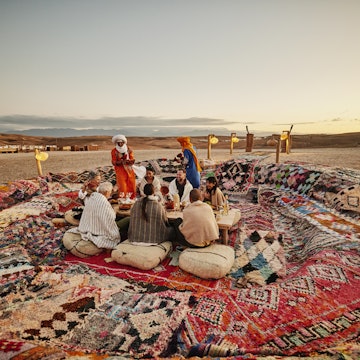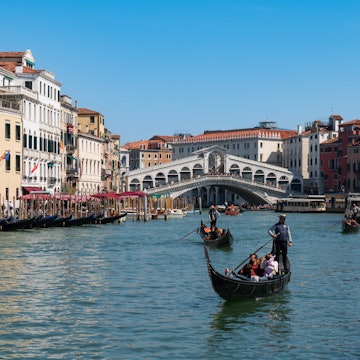

The Strait of Gibraltar from the summit of the Rock of Gibraltar. Joseph E.C. Cox/Shutterstock
A corner of Europe where British, Spanish and Moroccan cultures meet, Gibraltar is a truly one-of-a-kind destination featuring big doses of history, scenery and character within a mere 2.6 square miles.
While legally part of the UK and physically tucked into Spain, Gibraltar is just nine miles from Morocco, which is visible on a clear day. The Strait of Gibraltar, the waterway separating the territory and Morocco and connecting the Mediterranean Sea and Atlantic Ocean, is one of the busiest trade routes in the world.
Best known for its signature Rock of Gibraltar, this British Overseas Territory at the southern tip of Spain has long been one of the world’s most strategic crossroads. Over the centuries, it has passed several times over between Spanish, Moorish and British rule, resulting in a mix of iconic royal red phone booths and tapas bars, English pubs dotting Mediterranean beaches, and cafés that accept British pounds instead of euros.
Often overlooked in favor of Morocco’s markets or Andalucia’s white towns, the territory rewards those who visit with Mediterranean beaches and slices of winter sun that can compete with any established nearby locale. Whether you are looking for a fun stop on a road trip through southern Spain or wanting to firmly plant yourself in one spot for a lazy vacation, Gibraltar has much more to offer than just a photo at the top of a rock.
When should I go to Gibraltar?
Gibraltar experiences the same weather as Southern Spain, which means it offers sunny skies year-round.
Summertime in the British territory brings high UV exposure and Mediterranean heat, with average temperatures in the 80s. The winter months will be chillier, with the lowest temperatures hitting around 50ºF.
To enjoy warm weather but dodge crowds and peak pricing, shoulder months like May and September are ideal times to visit.
How much time should I spend in Gibraltar?
Gibraltar can be visited as part of a larger road trip through Spain, an intercontinental trip combined with Morocco or a stand-alone vacation that soaks in every corner of the small pocket, though most of its sights are doable in one to two days.
I spent two days in Gibraltar at the end of a big drive through Andalucía, and it was a wonderful way to cap off the trip. One day spent lazily strolling the streets, hitting some museums, and lounging on the beach, and the other spent hiking around the Rock of Gibraltar and enjoying all of the activities it offers.

Is it easy to get to and around Gibraltar?
Despite its mountainous terrain, Gibraltar is compact and easy to navigate. The main town is walkable, though the hilly climbs to the upper Rock are best tackled by cable car, bus, taxi or guided tour.
There is an airport inside Gibraltar, and it is highly popular with British travelers, thanks to the ease of travel compared to post-Brexit passport logistics in mainland Spain. Málaga and Jerez airports are also nearby, just a quick 1.5 to 2-hour drive to the border. Buses from across Spain are available, dropping passengers off just outside passport control.
There are several parking areas on the Spanish side, so visitors looking to ditch their rides to avoid expensive parking within Gibraltar can do so before walking across the border, through passport control and into the UK territory. The time it takes to get through can vary depending on various factors, such as the time of day and season.
Many also reach Gibraltar by sea. The port is a popular cruise ship stop, and some adventurers make use of the 1.5-hour ferries between Gibraltar and Tangier, Morocco, to jump continents.
Top things to do in Gibraltar
Climb the famed Rock of Gibraltar
Nearly synonymous with the territory itself, the Rock of Gibraltar has a rich and colorful history. The east side of the Rock is dotted with caves where Neanderthal fossils have revealed that humans lived in the area at least 127,000 years ago. Centuries later, Phoenician and Carthaginian sea traders used these same caves as places of worship between 800 and 200 BC, and the Romans dubbed the Rock Mons Calpe, one of the two Pillars of Hercules marking the end of the known world.
And this was all before Gibraltar played a central role in Moorish rule of the Iberian Peninsula for nearly 800 years, was retaken by the Spanish Catholics, captured by the British, reclaimed by Spain, and finally recaptured by Britain in 1783. History buffs can explore the Great Siege Tunnels, which were carved during the 18th-century siege and later expanded during WWII.
A visit to the Gibraltar Nature Reserve is another must around the Rock, home to the famous troupe of Barbary macaques. These mischievous monkeys have lived here for centuries and are an integral part of Gibraltar’s identity; it’s said that British rule will endure only as long as the macaques are around.
If you crave more of an adventure, there are a few hiking trails to take up the side of the mountain. Mediterranean Steps will take you around 45 minutes and deliver you right to the top of the limestone monolith, offering a clear view of Africa. Douglas Path is another famous trail, a snake path connecting the summit to the main town with plenty of scenic views along the way.
There are three ways to reach the top of the Rock: by cable car, taxi or on foot via the trails. For panoramic views, make a short detour to O’Hara’s Battery, Gibraltar’s highest point and just a short walk from the upper cable-car station.

Enter St Michael’s Cave
The most famous of the many caves and tunnels in the Rock, St Michael’s is a must-see. Once believed to be bottomless, the cave may be the origin of the belief that Gibraltar is linked to Africa through an underground passage. It is through this passage that the macaques are said to have reached Europe.
Visitors heading through St Michael's can now enjoy The Awakening, an immersive light and sound show that brings to life the already jaw-dropping stalactites. The cave also hosts numerous concerts and performances, so check out event websites for info on what’s on while you are in town.
Spot dolphins as they flit between continents
There are several local tour companies – such as Dolphin Safari – that offer dolphin-watching expeditions and other sea-based adventures, such as cave tours, whale watching and private charters. The area is primarily home to the common dolphin, bottlenose dolphin and the striped dolphin, with the mammals visible nearly every day in the bay and strait area.
Certain companies, like Dolphin Adventure Gibraltar, offer ticket combos with the Rock of Gibraltar cable car, giving a discount for those looking to explore the area by both land and sea.
Sunbathe in Sandy Bay
Covered in sand imported from the Sahara Desert, Sandy Bay is considered among the best beaches in Gibraltar. With fine sand and calm waters, the area offers an idyllic moment of rest during a busy sightseeing weekend. Catalan Bay is also a local favorite, decorated with pastel-colored houses and a small fishing village. A scenic hideaway, Catalan Bay is a must-see for those seeking some coastal peace and quiet.

My favorite things to do in Gibraltar
Sitting in Casemates Square – the main café hub in the town center – and people watching was the highlight of my time in Gibraltar. The territory’s cultural blend is on full display here: British architecture, Spanish flavors and Mediterranean energy all colliding in one lively plaza. After days exploring Andalusian cities and beaches, Gibraltar felt remarkably different, like stepping into world history as I crossed the border on foot.
Another favorite moment was wandering through the Alameda Gardens near the cable car. Free, quiet and beautifully landscaped, the gardens offered a needed peaceful pause after a weekend of sightseeing.
How much money do I need for Gibraltar?
Gibraltar can be notably costlier than mainland Spain, so it might be a bit of a surprise for your wallet if you pop over on a day trip. That said, it is also far cheaper than the mainland UK.
Night at a central hotel: between £120 and £250
Night in Emile Hostel dorm room: from £40
One-day Hopper pass for the bus (unlimited rides): £6
Coffee at Café Louis on Main Street: from £2
Club sandwich from The Little Rock: £12.95
Glass of wine at Aquaterra restaurant: from £3.50
Ticket to Gibraltar Nature Reserve with round-trip cable car (adult): £49
1.5-hour tour of major attractions with Gibraltar Taxi Association (4-person minimum): £90
What do I pack for Gibraltar?
Packing for Gibraltar is dependent on the time of year and which other spots you might be looping into your trip. Take a peek at the weather forecast before packing and consider whether you are heading for an extended beach-hopping holiday or a more culture-heavy trip. If you plan to visit any religious centers, pack appropriate clothing.
How do I get to Morocco from Gibraltar?
There are several ferry companies that service the route between Gibraltar and Morocco if you want to make the rather quick journey. Just make sure to book your ferry in advance if venturing to or from Morocco. Boats can fill up in the busy season, and it is better to plan ahead (though if your dates and times are flexible, you can wait a bit longer).
Most importantly, bring your passport and factor in extra time for passport control. While just a stroll from Spain, Gibraltar is outside the Schengen zone, and passports are checked going in and out.













